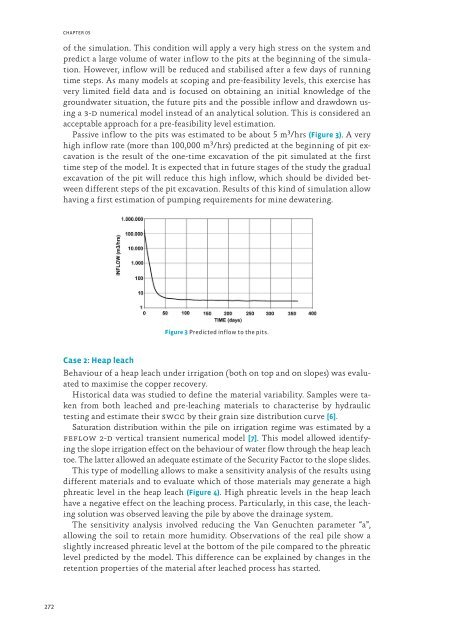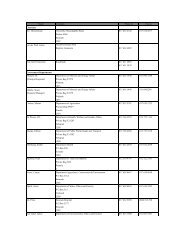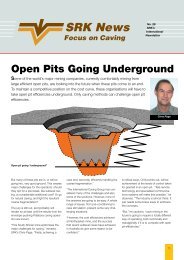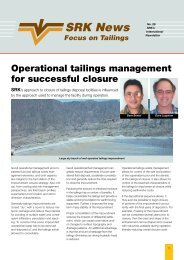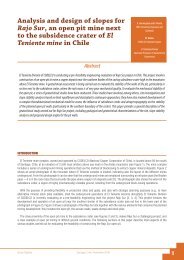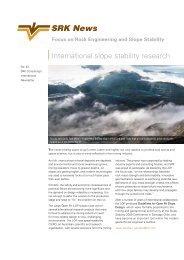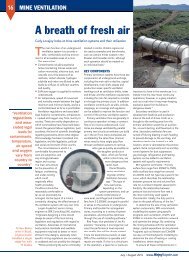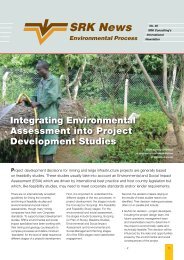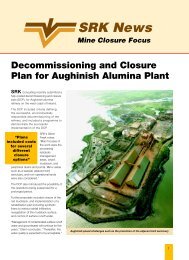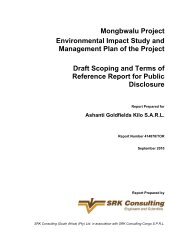Groundwater Flow Modelling Applications in Mining: Scopes and ...
Groundwater Flow Modelling Applications in Mining: Scopes and ...
Groundwater Flow Modelling Applications in Mining: Scopes and ...
Create successful ePaper yourself
Turn your PDF publications into a flip-book with our unique Google optimized e-Paper software.
272<br />
CHAPTER 05<br />
of the simulation. This condition will apply a very high stress on the system <strong>and</strong><br />
predict a large volume of water <strong>in</strong>flow to the pits at the beg<strong>in</strong>n<strong>in</strong>g of the simulation.<br />
However, <strong>in</strong>flow will be reduced <strong>and</strong> stabilised after a few days of runn<strong>in</strong>g<br />
time steps. As many models at scop<strong>in</strong>g <strong>and</strong> pre-feasibility levels, this exercise has<br />
very limited field data <strong>and</strong> is focused on obta<strong>in</strong><strong>in</strong>g an <strong>in</strong>itial knowledge of the<br />
groundwater situation, the future pits <strong>and</strong> the possible <strong>in</strong>flow <strong>and</strong> drawdown us<strong>in</strong>g<br />
a 3-d numerical model <strong>in</strong>stead of an analytical solution. This is considered an<br />
acceptable approach for a pre-feasibility level estimation.<br />
Passive <strong>in</strong>flow to the pits was estimated to be about 5 m 3 /hrs (Figure 3). A very<br />
high <strong>in</strong>flow rate (more than 100,000 m 3 /hrs) predicted at the beg<strong>in</strong>n<strong>in</strong>g of pit excavation<br />
is the result of the one-time excavation of the pit simulated at the first<br />
time step of the model. It is expected that <strong>in</strong> future stages of the study the gradual<br />
excavation of the pit will reduce this high <strong>in</strong>flow, which should be divided between<br />
different steps of the pit excavation. Results of this k<strong>in</strong>d of simulation allow<br />
hav<strong>in</strong>g a first estimation of pump<strong>in</strong>g requirements for m<strong>in</strong>e dewater<strong>in</strong>g.<br />
Case 2: Heap leach<br />
Figure 3 Predicted <strong>in</strong>flow to the pits.<br />
Behaviour of a heap leach under irrigation (both on top <strong>and</strong> on slopes) was evaluated<br />
to maximise the copper recovery.<br />
Historical data was studied to def<strong>in</strong>e the material variability. Samples were taken<br />
from both leached <strong>and</strong> pre-leach<strong>in</strong>g materials to characterise by hydraulic<br />
test<strong>in</strong>g <strong>and</strong> estimate their swcc by their gra<strong>in</strong> size distribution curve [6].<br />
Saturation distribution with<strong>in</strong> the pile on irrigation regime was estimated by a<br />
feflow 2-d vertical transient numerical model [7]. This model allowed identify<strong>in</strong>g<br />
the slope irrigation effect on the behaviour of water flow through the heap leach<br />
toe. The latter allowed an adequate estimate of the Security Factor to the slope slides.<br />
This type of modell<strong>in</strong>g allows to make a sensitivity analysis of the results us<strong>in</strong>g<br />
different materials <strong>and</strong> to evaluate which of those materials may generate a high<br />
phreatic level <strong>in</strong> the heap leach (Figure 4). High phreatic levels <strong>in</strong> the heap leach<br />
have a negative effect on the leach<strong>in</strong>g process. Particularly, <strong>in</strong> this case, the leach<strong>in</strong>g<br />
solution was observed leav<strong>in</strong>g the pile by above the dra<strong>in</strong>age system.<br />
The sensitivity analysis <strong>in</strong>volved reduc<strong>in</strong>g the Van Genuchten parameter “a”,<br />
allow<strong>in</strong>g the soil to reta<strong>in</strong> more humidity. Observations of the real pile show a<br />
slightly <strong>in</strong>creased phreatic level at the bottom of the pile compared to the phreatic<br />
level predicted by the model. This difference can be expla<strong>in</strong>ed by changes <strong>in</strong> the<br />
retention properties of the material after leached process has started.


